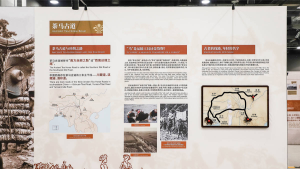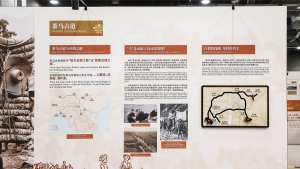在这里的展板上,您可以看到一张地图,这上面画的就是茶马古道了。茶马古道自从唐朝就已经有了,一直到民国时期,它都是沟通四川、西藏、云南和印度四个地区的重要交通路线。
The display panel here presents a map of the Ancient Tea Horse Road. The Ancient Tea Horse Road was opened during the Tang Dynasty and remained a key transportation route connecting Sichuan, Tibet, Yunnan, and India until the Republic of China.
在茶马古道上,马匹和茶叶都是商品。唐朝时期,藏区不产茶叶,但是产好马,而汉族地区呢,不产好马,却产茶叶。所以汉族地区的人就拿茶叶去换取藏区的马匹,这就是茶马互市,茶马古道就因此诞生了。后来,随着贸易往来的深入,汉族地区的丝绸、布匹、铁器和藏地的黄金、皮革、骡子、虫草等也成为了茶马古道上的畅销商品,茶马古道也成为了中国西南地区最重要的贸易路线之一。
On the Ancient Tea Horse Road, horses and tea were both commodities. During the Tang Dynasty, Tibetan areas did not produce tea, but bred excellent horses, while the Han was quite the contrary. Therefore, people in the Han areas came to Tibetan areas to exchange tea for horses, giving rise to the Tea Horse Market and Tea Horse Road. Later, due to deepening trade and exchanges, silk, cloth, and ironware of the Han areas and gold, leather, mules, and cordyceps from the Tibetan areas also became popular commodities on the Ancient Tea Horse Road, prompting the Ancient Tea Horse Road to become one of the most important trade routes in southwest China.
接下来我们去左后方看一看中国的桌椅板凳。
So next, let’s go to the back left and take a look at China’s tables, chairs, benches, and stools.




















 京公网安备11010502039775号
京公网安备11010502039775号





